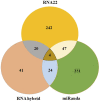Prediction of Site Directed miRNAs as Key Players of Transcriptional Regulators Against Influenza C Virus Infection Through Computational Approaches
- PMID: 35463952
- PMCID: PMC9023806
- DOI: 10.3389/fmolb.2022.866072
Prediction of Site Directed miRNAs as Key Players of Transcriptional Regulators Against Influenza C Virus Infection Through Computational Approaches
Abstract
MicroRNAs (miRNAs) are small non-coding RNAs that play critical roles in gene expression, cell differentiation, and immunity against viral infections. In this study, we have used the computational tools, RNA22, RNAhybrid, and miRanda, to predict the microRNA-mRNA binding sites to find the putative microRNAs playing role in the host response to influenza C virus infection. This computational research screened the following four miRNAs: hsa-mir-3155a, hsa-mir-6796-5p, hsa-mir-3194-3p and hsa-mir-4673, which were further investigated for binding site prediction to the influenza C genome. Moreover, multiple sites in protein-coding region (HEF, CM2, M1-M2, NP, NS1- NS2, NSF, P3, PB1 and PB2) were predicted by RNA22, RNAhybrid and miRanda. Furthermore, 3D structures of all miRNAs and HEF were predicted and checked for their binding potential through molecular docking analysis. The comparative results showed that among all proteins, HEF is higher in prevalence throughout the analysis as a potential (human-derived) microRNAs target. The target-site conservation results showed that core nucleotide sequence in three different strains is responsible for potential miRNA binding to different viral strains. Further steps to use these microRNAs may lead to new therapeutic insights on fighting influenza virus infection.
Keywords: HEF; RNAComposer; RStudio; influenza C virus; miRNAs; mirbase; target site prediction.
Copyright © 2022 Hassan, Iqbal, Naqvi, Alashwal, Moustafa and Kloczkowski.
Conflict of interest statement
The authors declare that the research was conducted in the absence of any commercial or financial relationships that could be construed as a potential conflict of interest.
Figures














Similar articles
-
Exploration of microRNAs as transcriptional regulator in mumps virus infection through computational studies.Sci Rep. 2024 Aug 14;14(1):18850. doi: 10.1038/s41598-024-67717-z. Sci Rep. 2024. PMID: 39143101 Free PMC article.
-
A computational method for predicting regulation of human microRNAs on the influenza virus genome.BMC Syst Biol. 2013;7 Suppl 2(Suppl 2):S3. doi: 10.1186/1752-0509-7-S2-S3. Epub 2013 Oct 14. BMC Syst Biol. 2013. PMID: 24565017 Free PMC article.
-
MicroRNA-205-5p: A potential therapeutic target for influenza A.J Cell Mol Med. 2022 Dec;26(23):5917-5928. doi: 10.1111/jcmm.17615. Epub 2022 Nov 20. J Cell Mol Med. 2022. PMID: 36403222 Free PMC article.
-
Integrated analysis of microRNA-mRNA expression in A549 cells infected with influenza A viruses (IAVs) from different host species.Virus Res. 2019 Apr 2;263:34-46. doi: 10.1016/j.virusres.2018.12.016. Epub 2018 Dec 31. Virus Res. 2019. PMID: 30605755
-
Regulation of the MIR155 host gene in physiological and pathological processes.Gene. 2013 Dec 10;532(1):1-12. doi: 10.1016/j.gene.2012.12.009. Epub 2012 Dec 14. Gene. 2013. PMID: 23246696 Review.
Cited by
-
Exploration of microRNAs as transcriptional regulator in mumps virus infection through computational studies.Sci Rep. 2024 Aug 14;14(1):18850. doi: 10.1038/s41598-024-67717-z. Sci Rep. 2024. PMID: 39143101 Free PMC article.
-
Loss of miRNA-Mediated VEGFA Regulation by SNP-Induced Impairment: A Bioinformatic Analysis in Diabetic Complications.Biomedicines. 2025 May 14;13(5):1192. doi: 10.3390/biomedicines13051192. Biomedicines. 2025. PMID: 40427019 Free PMC article.
-
Unveiling the hemolymphatic miRNome composition of the schistosomiasis vector snail Biomphalaria glabrata.Curr Res Parasitol Vector Borne Dis. 2025 Apr 22;7:100262. doi: 10.1016/j.crpvbd.2025.100262. eCollection 2025. Curr Res Parasitol Vector Borne Dis. 2025. PMID: 40666502 Free PMC article.
-
Computational Screening to Predict MicroRNA Targets in the Flavivirus 3' UTR Genome: An Approach for Antiviral Development.Int J Mol Sci. 2024 Sep 21;25(18):10135. doi: 10.3390/ijms251810135. Int J Mol Sci. 2024. PMID: 39337625 Free PMC article.
-
Oncomeric Profiles of microRNAs as New Therapeutic Targets for Treatment of Ewing's Sarcoma: A Composite Review.Genes (Basel). 2023 Sep 23;14(10):1849. doi: 10.3390/genes14101849. Genes (Basel). 2023. PMID: 37895198 Free PMC article. Review.
References
-
- Ali Q., Jamal A., Ullah S., Waqar A. B. (2020). Male Predominant Association with Apolipoprotein B mRNA-Editing Enzyme, Catalytic Polypeptide-like 3G Variants (Rs6001417, Rs35228531, Rs8177832) Predict protection against HIV-1 Infection. Advancements Life Sci. 7 (2), 91–97.
-
- Asif M., Nawaz S., Bhutta Z. A., Kulyar M. F.-e.-A., Rashid M., Shabir S., et al. (2020). Viral Outbreaks: A Real Threat to the World. Advancements Life Sci. 8 (1), 08–19.
-
- Betel D., Wilson M., Gabow A., Marks D. S., Sander C. (2008). The microRNA.Org Resource: Targets and Expression. Nucleic Acids Res. 36 (Suppl. l_1), D149–D153. 10.1093/nar/gkm995 - DOI - PMC - PubMed
Grants and funding
LinkOut - more resources
Full Text Sources
Miscellaneous

